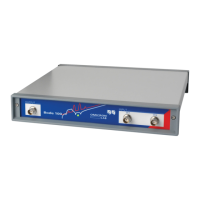Bode 100 User Manual
76
The Probe Calibration will be switched off automatically if the following
parameters are changed:
• Reference mode (internal/external reference)
• Conversion ratio of external probes (see 9.4 "Using Probes" on page 125)
• Input resistance of channel 1 and/or channel 2 (low/high impedance)
Hint: Use the Probe Calibration if measurement parameters have to be
changed often during the measurements. You will save time because you do not
need to recalibrate the Bode 100 each time you changed the parameters.
7.1.2 User Calibration
The User Calibration is the most accurate calibration method available with the
Bode 100. The User Calibration is performed directly at the exact
measurement frequencies. In the Gain/Phase and Impedance/Reflection
measurement modes, the Bode 100 is calibrated at the source frequency. In the
Frequency Sweep modes, the calibration is performed at the exact frequencies
specified by the measurement points.
The User Calibration allows changing the following parameters without the
need of recalibrating the Bode 100:
• Source level
• Attenuator 1 and attenuator 2
• Receiver bandwidth
•Zoom without the Copy from Zoom function (see "Copy from Zoom" on
page 107)
The User Calibration will be switched off automatically if one of the following
parameters is changed:
• Frequency values
• Sweep mode (linear/logarithmic)
• Number of measurement points (in the Frequency Sweep modes)
• Reference mode (internal/external reference)
• Conversion ratio of external probes (see 9.4 "Using Probes" on page 125)
• Input resistance of channel 1 and/or channel 2 (low/high impedance)
•Zoom with the Copy from Zoom function (see "Copy from Zoom" on
page 107)

